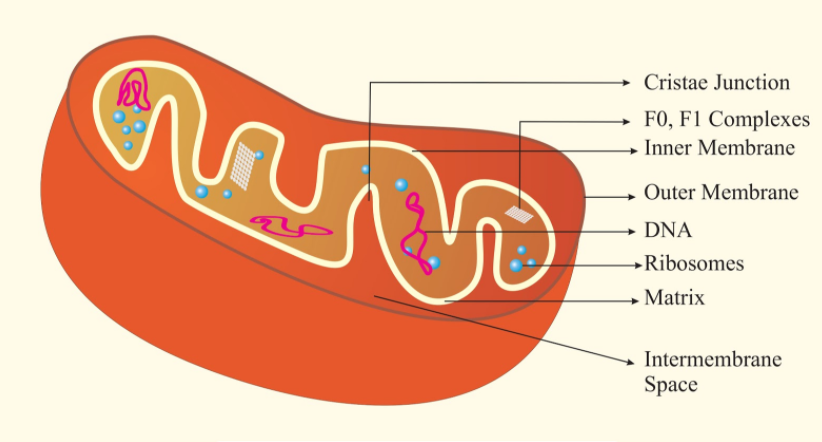
Answer
441.6k+ views
Hint: Mitochondria is the organelle in which the Krebs cycle and ETS reactions of the cellular respiration take place. A structure analogous to mitochondria is seen in prokaryotic organisms known as the mesosome which is the extension of the cell membrane into the cytoplasm.
Complete answer:
Mitochondria is present in the aerobic organisms only as the aerobic part of the cellular respiration takes place in the mitochondria. ATP is formed by the reactions of the Krebs cycle in the mitochondrial matrix and Electron Transport System (ETS) in the inner membrane of the mitochondria. ETS builds an electrochemical gradient of protons across the inner membrane which store potential energy in them. When a proton flows out of this inner membrane, energy is released which is trapped by the ATP synthetase complex to produce ATP. This process only takes place in aerobic organisms.
Additional Information:
Let us know more about the cell organelle mitochondria (singular: mitochondrion).
-Mitochondria is not easily seen in the microscope unless stained by special stains like Janus green.
-The number of mitochondria in a cell depends upon the physiological activity it has to perform.
-The mitochondrion is made up of a double membrane structure known as the outer membrane and inner membrane.
-These membranes divide the mitochondria into an outer compartment and an inner compartment.
-The inner compartment is filled with a dense homogeneous substance known as the matrix whereas the outer compartment has infoldings towards the matrix known as the cristae.
-Different types of enzymes are present on each of the membranes according to the functions they need to perform.
So, the correct option is ‘Aerobic organism only’.

Note: -Mitochondria and chloroplasts are semiautonomous organelles which means they have their own DNA and protein synthesis machinery but are dependent on the nucleus for some functions.
-Mitochondria and chloroplasts are known as endosymbionts which means that they are prokaryotic bacteria that started living inside the eukaryotic cells as symbionts.
-A structure analogous to mitochondria is seen in prokaryotes known as mesosomes.
Complete answer:
Mitochondria is present in the aerobic organisms only as the aerobic part of the cellular respiration takes place in the mitochondria. ATP is formed by the reactions of the Krebs cycle in the mitochondrial matrix and Electron Transport System (ETS) in the inner membrane of the mitochondria. ETS builds an electrochemical gradient of protons across the inner membrane which store potential energy in them. When a proton flows out of this inner membrane, energy is released which is trapped by the ATP synthetase complex to produce ATP. This process only takes place in aerobic organisms.
Additional Information:
Let us know more about the cell organelle mitochondria (singular: mitochondrion).
-Mitochondria is not easily seen in the microscope unless stained by special stains like Janus green.
-The number of mitochondria in a cell depends upon the physiological activity it has to perform.
-The mitochondrion is made up of a double membrane structure known as the outer membrane and inner membrane.
-These membranes divide the mitochondria into an outer compartment and an inner compartment.
-The inner compartment is filled with a dense homogeneous substance known as the matrix whereas the outer compartment has infoldings towards the matrix known as the cristae.
-Different types of enzymes are present on each of the membranes according to the functions they need to perform.
So, the correct option is ‘Aerobic organism only’.

Note: -Mitochondria and chloroplasts are semiautonomous organelles which means they have their own DNA and protein synthesis machinery but are dependent on the nucleus for some functions.
-Mitochondria and chloroplasts are known as endosymbionts which means that they are prokaryotic bacteria that started living inside the eukaryotic cells as symbionts.
-A structure analogous to mitochondria is seen in prokaryotes known as mesosomes.
Recently Updated Pages
10 Examples of Evaporation in Daily Life with Explanations

10 Examples of Diffusion in Everyday Life

1 g of dry green algae absorb 47 times 10 3 moles of class 11 chemistry CBSE

What is the meaning of celestial class 10 social science CBSE

What causes groundwater depletion How can it be re class 10 chemistry CBSE

Under which different types can the following changes class 10 physics CBSE

Trending doubts
Fill the blanks with the suitable prepositions 1 The class 9 english CBSE

Which are the Top 10 Largest Countries of the World?

How do you graph the function fx 4x class 9 maths CBSE

Differentiate between homogeneous and heterogeneous class 12 chemistry CBSE

Difference between Prokaryotic cell and Eukaryotic class 11 biology CBSE

Change the following sentences into negative and interrogative class 10 english CBSE

The Equation xxx + 2 is Satisfied when x is Equal to Class 10 Maths

Why is there a time difference of about 5 hours between class 10 social science CBSE

Give 10 examples for herbs , shrubs , climbers , creepers




